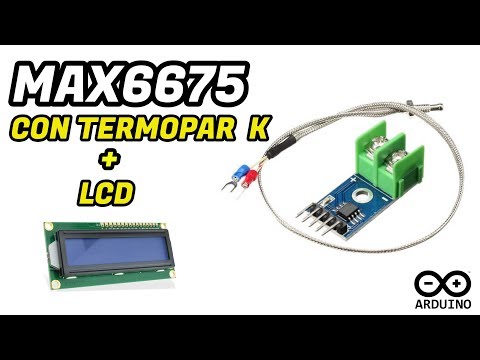Accurate Temperature Measurement with Arduino Using MAX6675 Thermocouple K Sensor and Cold Junction Compensation Using SPI
Accurate temperature measurement is essential in numerous applications, from industry to home automation. In this article, we will explore how to use the MAX6675 thermocouple K sensor together with Arduino to obtain accurate temperature measurements. Additionally, we will learn how to compensate for cold junction using the SPI communication interface. If you are interested in delving into the fascinating world of temperature measurement with Arduino, read on!
Effective methods for measuring temperature using a thermocouple
Accurate temperature measurement is essential in a wide variety of applications, from industry to scientific research. One of the most used and effective methods to measure temperature is using a thermocouple.
A thermocouple is a device that generates a voltage difference in response to changes in temperature. It is made up of two different metals that are joined together at one end, known as the measuring junction, and connected to a voltmeter at the other end. When the temperature at the measuring junction changes, a voltage difference is produced that is proportional to the temperature.
There are several effective methods to measure temperature using a thermocouple. Below are some of the most common:
1. Voltage comparison method: This method consists of comparing the voltage difference generated by the thermocouple with the voltage difference generated by a known temperature reference. A voltmeter is used to measure both voltage differences and, through mathematical calculations, the unknown temperature is determined.
2. Room temperature compensation method: In this method, a second thermocouple connected to a known temperature reference is used to measure the ambient temperature. The voltage difference generated by this second thermocouple is used to compensate for variations in ambient temperature and obtain a more accurate temperature measurement at the measurement junction.
3. Fixed point calibration method: This method is based on thermocouple calibration using fixed reference points, such as the melting point of ice and the boiling point of water. Measurements are made at these known points and correction coefficients are established that allow measurements to be adjusted in other temperature ranges.
4. Calibration method by calibration curve: In this method, a series of measurements are made at different temperatures using a reference thermometer and a thermocouple. The data obtained is used to construct a calibration curve that relates the voltage difference generated by the thermocouple to the temperature. This curve is later used to convert voltage difference measurements to temperature measurements.
Everything you need to know about the operation of the MAX6675 module
The MAX6675 module is an electronic device used to measure temperature using a type K thermocouple. It is widely used in electronics and automation projects as it offers high precision and ease of use.
Features:
- High accuracy: The MAX6675 module can measure temperatures in a range of -200°C to +1.200°C with an accuracy of ±2°C. This makes it ideal for applications requiring exact measurements.
- SPI interface: The module communicates with the microcontroller through a Serial Peripheral Interface (SPI), which makes it easy to connect and configure in different projects.
- Cold junction compensation: The MAX6675 is designed to compensate for ambient temperature and potential difference at the cold junction of the thermocouple, improving measurement accuracy.
- Low energy consumption: This module has low power consumption, making it suitable for power-constrained applications.
Connection and configuration:
The MAX6675 module connects to the microcontroller using four pins: SCK (Serial Clock), CS (Chip Select), MISO (Master Input Slave Output) and VCC (5V). Additionally, the type K thermocouple must be connected to the corresponding pins of the module.
To configure the module and perform measurements, the following steps must be followed:
1. Initialize SPI communication with the microcontroller.
2. Set the module to continuous measurement mode.
3. Read temperature data from MAX6675 via SPI communication.
4. Perform the necessary calculation to obtain the temperature in degrees Celsius or Fahrenheit, depending on the needs of the project.
It is important to note that each microcontroller can have its own library or library to interact with the MAX6675 module, which facilitates its implementation on different platforms.
Applications:
The MAX6675 module is used in a wide range of applications, such as:
– Temperature control in air conditioning and heating systems.
– Temperature monitoring in refrigeration and freezing systems.
– Temperature control in industrial processes.
– Temperature monitoring in security and fire prevention systems.
The detailed operation of a thermocouple temperature sensor
A thermocouple temperature sensor is a device used to measure the temperature of an object or environment. Its operation is based on the principle of thermoelectricity, which establishes that there is a relationship between temperature and the generation of an electrical potential difference in a closed circuit formed by two different metals.
When one end of the thermocouple is exposed to a different temperature than the other end, a temperature difference occurs in the circuit. This temperature difference generates an electrical potential difference, known as electromotive force (EMF), which can be measured and used to determine temperature.
Components of a thermocouple temperature sensor
A thermocouple temperature sensor consists of the following components:
1. Metal Pairs: A thermocouple is made up of two different metals joined together at a point, known as the measuring junction. The most commonly used metals are chromium-nickel (chromoel-alumel) and iron-constantan. Each pair of metals has a unique voltage-temperature curve, allowing a wide range of temperatures to be measured.
2. Extension cables: Extension wires are connected to the ends of the thermocouple and are used to carry the voltage signal generated by the thermocouple to a measuring device, such as a thermometer or data logger. These cables are made of the same material as the thermocouple to avoid the appearance of an additional junction that could affect the accuracy of the measurement.
3. Connector: The connector is the connection point between the extension cables and the measuring device. It is usually a thermocouple type connector, which allows an easy and safe connection.
4. Protection: Depending on the application, the thermocouple may require some additional protection. For example, in aggressive or high vibration environments, a protective sheath can be used to protect the thermocouple from mechanical or chemical damage.
Operating principle
When one end of the thermocouple is exposed to a different temperature than the other end, a temperature difference occurs at the measuring junction. This temperature difference generates an EMF in the thermocouple circuit, proportional to the temperature difference between the two ends.
And so, friends, we have come to the end of this exciting article on how to accurately measure temperature using Arduino and the MAX6675 thermocouple K sensor. Who knew electronics could be so hot!
I hope that now you are more prepared than ever to measure the temperature of your projects with surgeon-like precision. But hey! Don't forget to always compensate for the cold junction, which although it may sound like a rock band, is crucial to obtain reliable results.
You know, if you want to be the gurus of temperature measurement, do not hesitate to take out your Arduino and put into practice everything you have learned here. And if you feel cold about any concept, remember that at Polaridades we will always be here to warm you up with interesting content.
Until next time, thermocouple friends, and may your measurements always be 'at the top of the degrees'.




Post Comment